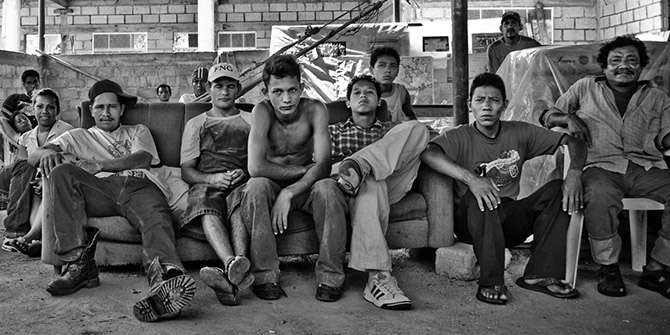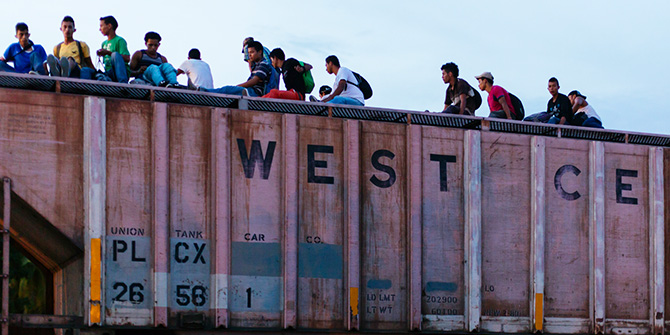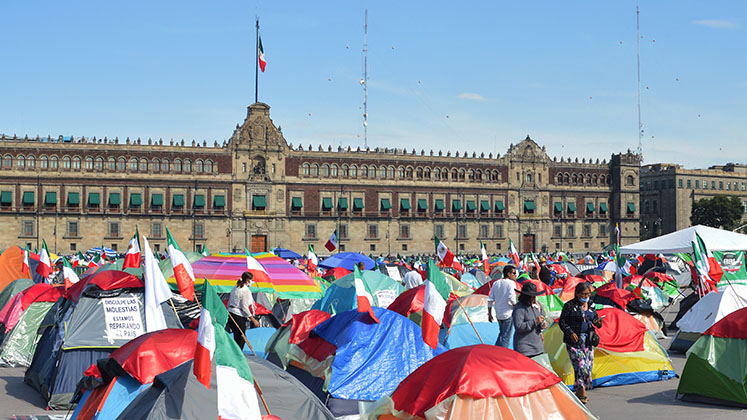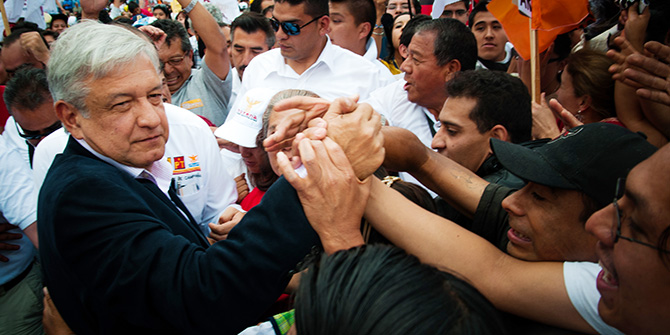 Militarisation of Mexico’s southern border has been increasing for decades, but the recent decision of Andrés Manuel López Obrador’s government to continue and even reinforce this trend will only intensify the violence and vulnerability that transit migrants already face, writes Alejandra Díaz de Leon (LSE Sociology).
Militarisation of Mexico’s southern border has been increasing for decades, but the recent decision of Andrés Manuel López Obrador’s government to continue and even reinforce this trend will only intensify the violence and vulnerability that transit migrants already face, writes Alejandra Díaz de Leon (LSE Sociology).
The recent actions of the government of Andrés Manuel López Obrador (AMLO) are just the latest – and harshest – phase of a militarisation of Mexican border control that began in 2001 in its southern states. AMLO’s government, like those that came before, appears to be labouring under the illusion that increasing controls and obstacles for clandestine migrants will stop them from migrating. But as during previous episodes, ramping up control of the southern border will only make crossing Mexico more dangerous and expensive for migrants.

The longstanding militarisation of Mexico’s southern border
The militarisation of the southern border began when the National Migration Institute (INM), backed by the United States, implemented the Southern Plan (Plan Sur) in July of 2001. After the 9/11 terrorist attacks, the Southern Plan became even more restrictive.
Its objective was to halt Central American transit migration through Mexico in order to negotiate better conditions for Mexican migrants in the United States. As a result of the Plan, the INM established two inspection cordons in the southern states of Mexico, created a deportation programme, and reinforced so-called Beta Groups that offer aid to transit migrants but that have also been accused of acting as a kind of intelligence network for the INM’s migration control efforts. One of the explicit objectives of the Plan was to increase the number of detained migrants and to stop the transit of undocumented migrants.
Members of the INM alongside the Mexican police and the army participated in the implementation of the Plan. Having this army and police presence in the southern states to search for migrants sent a very strong signal that controlling clandestine migration was a national security issue. It also linked undocumented migration to crime. Groups that defended and helped transit migrants suffered abuse and threats.
This intensification of border control pushed clandestine migrants on to more dangerous and isolated routes. This in turn increased exposure to robberies, extorsion, abuse, sexual violence, and kidnapping at the hands of criminal gangs, traffickers, and the authorities. In 2009 and 2011, the Mexican National Human Rights Commission published reports documenting in detail migrants’ vulnerability to kidnapping by criminals and organised groups – some of whom were working with agents of the state.
The government of Enrique Peña Nieto further added to the militarisation of the southern border in 2014 via the Southern Border Programme (Programa Frontera Sur). Under this programme, the government established three contention cordons in the southern states of Mexico, and the overall number of checkpoints was increased. Mobile checkpoints were also set up to collect transit migrants’ biometric data.

In addition, the government brokered a deal with the train companies to increase the speed of the freight train known as “The Beast” in order to prevent migrants from climbing aboard and riding north. Again, the kidnappings, murders, rapes, and general sexual violence increased. Even though migrants were pushed towards ever more obscure and dangerous routes, many were apprehended, and in 2015 Mexico deported more Central American migrants than even the United States.
The costs of AMLO’s new militarisation
During my fieldwork in Chiapas and Tabasco in 2015 and 2016, I documented firsthand the effects of these kinds of obstacles on the experience of the migrants. Many told me that they had to walk for days in the jungle without water or food; they had deep scratches and huge blisters on the soles of their feet from walking. Some had been extorted, beaten, or kidnapped. The migrants who had crossed before 2014 and then again in 2015 or 2016 were shocked by the increased level of control and violence around the border. Still, most of them were willing to risk it in order to keep moving north towards the United States.
Recently, president Trump threatened to impose tariffs on Mexican products if the Mexican government didn’t “stop” clandestine migration through Mexico. AMLO’s government responded by once again intensifying controls in the south.
His government sent the newly created National Guard to the southern border, increased the number of checkpoints, started carrying out raids in border towns, and arrested two prominent migrant rights activists. This has forced clandestine migrants to remain hidden, leaving them without access to the lifesaving services of NGOs and volunteers. There has also been a spike in violence, as many activists and migration scholars predicted. On 19 June, 2019, for example, Mexican police officers killed a Salvadoran woman called María Escobar and injured two other migrants when they opened fire on their group in Veracruz.
By again ramping-up the previous militarisation of border enforcement, AMLO’s government has once again made the migration route more difficult, expensive, and dangerous for migrants. The presence of security forces in the southern states has reinforced the message that migrants are criminals and need to be controlled with violence. These policies will only intensify the violence and vulnerability that transit migrants already face as they cross Mexico.
Notes:
• The views expressed here are of the authors rather than the Centre or LSE
• Please read our Comments Policy before commenting




